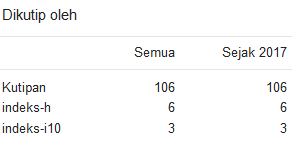Exploring Students' Critical Thinking Skills Through Expressive Responses: Science And Religion Integration Training
Abstract
Keywords
Full Text:
PDF (Bahasa Indonesia)References
Altinyelken, H. K. (2021). Critical thinking and non-formal Islamic education: Perspectives from young Muslims in the Netherlands. Contemporary Islam, 15(3), 267–285. https://doi.org/10.1007/s11562-021-00470-6
Barnett, J., & Francis, A. (2011). Using higher order thinking questions to foster critical thinking: A classroom study. Educational Psychology - EDUC PSYCHOL-UK, 32, 1–11. https://doi.org/10.1080/01443410.2011.638619
Bengtsson, H. (2020). Didaktiska reflektioner om judendom, stereotyper och tankefigurer. Nordisk Judaistik/Scandinavian Jewish Studies, 31(2), 3–20. https://doi.org/10.30752/nj.89966
Burney, S. F. (2023). Shoaib Malik’s “Islam and Evolution”: Sociological Reflections on the Developing Engagement of British Muslim Leadership with Science. Theology and Science, 21(4), 696–707. https://doi.org/10.1080/14746700.2023.2255952
Chinnery, A., Hare, W., Kerr, D., & Okshevsky, W. (2007). Teaching Philosophy of Education: The Value of Questions. Interchange, 38(2), 99–118. https://doi.org/10.1007/s10780-007-9025-0
Cobern, W. W. (1996). Worldview theory and conceptual change in science education. Science Education, 80(5), 579–610. https://doi.org/10.1002/(SICI)1098-237X(199609)80:5<579::AID-SCE5>3.0.CO;2-8
Diyana, T. N. (2022). KTIQ journey: A memoir kupas tuntas rahasia juara karya tulis ilmiah Al-Qur’an dilengkapi dengan karya terbaik KTIQ dan MMQ. Delta Pijar Khatulistiwa.
Fancourt, N., & Guilfoyle, L. (2022). Interdisciplinary perspective-taking within argumentation: Students’ strategies across science and religious education. Journal of Religious Education, 70(1), 1–23. https://doi.org/10.1007/s40839-021-00143-9
Hammersley, M., & Atkinson, P. (2019). Ethnography: Principles in practice (4 Edition). Routledge.
Hanley, P., Bennett, J., & Ratcliffe, M. (2014). The Inter-relationship of Science and Religion: A typology of engagement. International Journal of Science Education, 36(7), 1210–1229. https://doi.org/10.1080/09500693.2013.853897
Hashim, R. (2024). Critical Thinking and Democratic Citizenship in a Diverse Islamic Education Context: The Relevance of the Community of Philosophical Inquiry. In The Pedagogy of the Community of Philosophical Enquiry as Citizenship Education. Routledge.
Huth, K., Brown, R., & Usher, W. (2021). The use of story to teach religious education in the early years of primary school: A systematic review of the literature. Journal of Religious Education, 69(2), 253–272. https://doi.org/10.1007/s40839-021-00140-y
Inoue, S., Wang, Y., Kawai, Y., & Sumiya, K. (2022). Question Support Method to Promote Critical Thinking Using Lecture Slide Structure in On-Demand Courses. In Y.-H. Tseng, M. Katsurai, & H. N. Nguyen (Eds.), From Born-Physical to Born-Virtual: Augmenting Intelligence in Digital Libraries (pp. 509–515). Springer International Publishing. https://doi.org/10.1007/978-3-031-21756-2_43
Jørgensen, C. S. (2014). Som du spør får du svar?: En empirisk studie av skriving i religions- og livssynsfaget [Doctoral thesis, Norges teknisk-naturvitenskapelige universitet, Fakultet for samfunnsvitenskap og teknologiledelse, Program for lærerutdanning]. https://ntnuopen.ntnu.no/ntnu-xmlui/handle/11250/270337
Krogstad, K. (2024). Teaching religious stories in lower primary school: A Norwegian case study of 8-year-old students’ perception of the Moses narratives. British Journal of Religious Education, 0(0), 1–13. https://doi.org/10.1080/01416200.2024.2330921
Michalski, P., Kasprzak, M., Siedlaczek, M., & Kubica, A. (2020). The impact of knowledge and effectiveness of educational intervention on readiness for hospital discharge and adherence to therapeutic recommendations in patients with acute coronary syndrome. Medical Research Journal. https://doi.org/10.5603/MRJ.a2020.0023
Qureshi, O. (2021). Science Curriculum from an Islamic Worldview. In Curriculum Renewal for Islamic Education. Routledge.
Reffhaug, M. B. A., Jegstad, K. M., & Andersson-Bakken, E. (2022). Kritisk tenkning – fra intensjon til praksisfortolkning: En analyse av barnetrinnslæreres forståelse av kritisk tenkning. Acta Didactica Norden, 16(2). https://doi.org/10.5617/adno.8989
Saefi, M. (2024). Teaching Evolution in State Islamic Religious Colleges: A Strategy for Exploring and Increasing Acceptance among Biology Students [Doctoral thesis]. Universitas Negeri Malang.
Southerland, S., Gallard, A., & Callihan, L. (2011). Examining Teachers’ Hurdles to ‘Science for All.’ International Journal of Science Education, 33(16), 2183–2213. https://doi.org/10.1080/09500693.2010.530698
Stenmark, M. (2013). Typologies in Science and Religion. In A. L. C. Runehov & L. Oviedo (Eds.), Encyclopedia of Sciences and Religions (pp. 2309–2309). Springer Netherlands. https://doi.org/10.1007/978-1-4020-8265-8_1448
Widianingsih, S. A., Susilo, S., Kartikawati, E., & Anugrah, D. (2022). Exploring Science Student’s Perceptions During Practical Work On Animal Structure Courses Using A Rasch Modeling Approach. Journal of Positive School Psychology, 6(9), Article 9.
Yunus, R. M., Padela, A. I., Khan, S., & Mohamad, M. Y. (2024). Tackling ‘Big’ questions at the bioscience-Islam interface: Reporting on the efficacy of an educational programme designed for Muslim high school students. International Journal of Science Education, 1–25. https://doi.org/10.1080/09500693.2024.2367774
DOI: https://doi.org/10.30736/jab.v8i2.1059
Refbacks
- There are currently no refbacks.

This work is licensed under a Creative Commons Attribution-ShareAlike 4.0 International License.
Indexing at :
Associated with :

Jurnal Abdimas Berdaya is licensed under a Creative Commons Attribution-NonCommercial-ShareAlike 4.0 International License.
Editorial Office
Jurnal Abdimas Berdaya
1.png) Jl. Veteran 53 A Lamongan, Kampus Universitas Islam Lamongan
Jl. Veteran 53 A Lamongan, Kampus Universitas Islam Lamongan
 jab@unisla.ac.id
jab@unisla.ac.id

_(1).png)
_.png)
_(2)_(1).jpg)

.png)


_.png)
.png)
1.png)
1.png)
_(1).jpg)





_(1).jpg)
.png)

.png)
.png)


